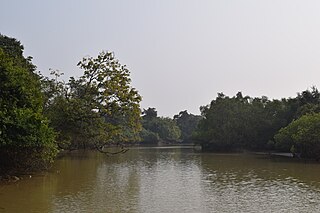
Genus is a taxonomic rank above species and below family as used in the biological classification of living and fossil organisms as well as viruses. In binomial nomenclature, the genus name forms the first part of the binomial species name for each species within the genus.

Convolvulaceae, commonly called the bindweeds or morning glories, is a family of about 60 genera and more than 1,650 species. These species are primarily herbaceous vines, but also include trees, shrubs and herbs. The tubers of several species are edible, the best known of which is the sweet potato.

Tilapia is the common name for nearly a hundred species of cichlid fish from the coelotilapine, coptodonine, heterotilapine, oreochromine, pelmatolapiine, and tilapiine tribes, with the economically most important species placed in the Coptodonini and Oreochromini. Tilapia are mainly freshwater fish inhabiting shallow streams, ponds, rivers, and lakes, and less commonly found living in brackish water. Historically, they have been of major importance in artisanal fishing in Africa, and they are of increasing importance in aquaculture and aquaponics. Tilapia can become a problematic invasive species in new warm-water habitats such as Australia, whether deliberately or accidentally introduced, but generally not in temperate climates due to their inability to survive in cold water.

The Integrated Taxonomic Information System (ITIS) is an American partnership of federal agencies designed to provide consistent and reliable information on the taxonomy of biological species. ITIS was originally formed in 1996 as an interagency group within the US federal government, involving several US federal agencies, and has now become an international body, with Canadian and Mexican government agencies participating. The database draws from a large community of taxonomic experts. Primary content staff are housed at the Smithsonian National Museum of Natural History and IT services are provided by a US Geological Survey facility in Denver. The primary focus of ITIS is North American species, but many biological groups exist worldwide and ITIS collaborates with other agencies to increase its global coverage.

Bhitarkanika Mangroves is a mangrove wetland in Odisha, India, covering an area of 650 km (400 mi) in the Brahmani River and Baitarani River deltas.

An IUCN Red List Critically Endangered species is one that has been categorized by the International Union for Conservation of Nature as facing an extremely high risk of extinction in the wild. As of December 2023, of the 157,190 species currently on the IUCN Red List, 9,760 of those are listed as Critically Endangered, with 1,302 being possibly extinct and 67 possibly extinct in the wild.
Limnocythere is a genus of ostracod crustaceans in the family Limnocytheridae. It contains the following extant species :

Water-penny beetles are a family of 272 species of aquatic beetles found on all continents except Antarctica, in both tropical and temperate areas. The young, which live in water, resemble tiny pennies. The larvae feed – usually nocturnally – on algae on rock surfaces. The presence of water-penny larvae in a stream can be used as a test for the quality of the water, as they are pollution-sensitive. They cannot live in habitats where rocks acquire a thick layer of algae, fungi, or inorganic sediment. Therefore, their presence along with other diverse phyla signifies good-quality water. They are around 6 to 10 millimeters in length.
The Reptile Database is a scientific database that collects taxonomic information on all living reptile species. The database focuses on species and has entries for all currently recognized ~13,000 species and their subspecies, although there is usually a lag time of up to a few months before newly described species become available online. The database collects scientific and common names, synonyms, literature references, distribution information, type information, etymology, and other taxonomically relevant information.

Elmidae, commonly known as riffle beetles, is a family of beetles in the superfamily Byrrhoidea described by John Curtis in 1830. Both adults and larvae are usually aquatic, living under rocks in fast-flowing shallow areas of streams, such as riffles, feeding on algae and biofilms. There are more than 150 genera and 1,500 described species in Elmidae. The oldest record of the group is Cretohypsilara from the Cenomanian aged Burmese amber.

iNaturalist is an American 501(c)(3) nonprofit social network of naturalists, citizen scientists, and biologists built on the concept of mapping and sharing observations of biodiversity across the globe. iNaturalist may be accessed via its website or from its mobile applications. iNaturalist includes an automated species identification tool, and users further assist each other in identifying organisms from photographs. As of 24 February 2024, iNaturalist users had contributed approximately 172,751,520 observations of plants, animals, fungi, and other organisms worldwide, and around 350,000 users were active in the previous 30 days.
Harley Procter Brown Jr. was an American biologist and an expert in certain types of aquatic beetles. He described over forty new species in his career.
Psephenus falli is a species of water penny beetle in the family Psephenidae. It is found on the west coast of North America.

Psephenus is a genus of water penny beetles in the family Psephenidae. There are about 13 described species in Psephenus.
Aradus vadosus is a species of flat bug in the family Aradidae. It is found in North America.
Psephenus texanus, the Texas water penny, is a species of water penny beetle in the family Psephenidae. It is found in Texas and northeastern Mexico.
Asplanchna is a genus of rotifers belonging to the family Asplanchnidae.
John George Gehring was an American medical doctor who specialised in neurology.










